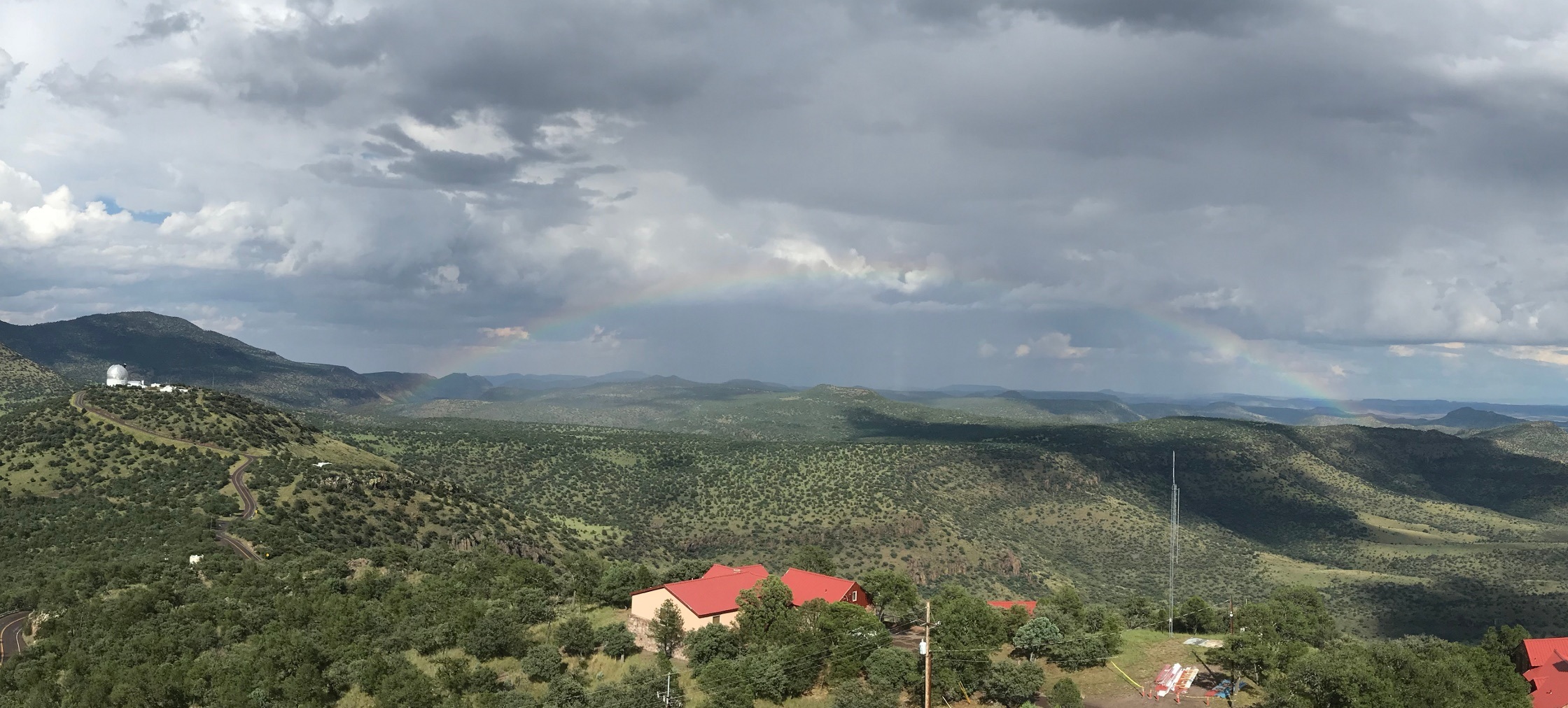Asteroid hunter from Piszkéstető
After sunset he aims his telescope towards stars, during daytime he supports
other enthusiasts with same passion as his own. His original profession is
geography teacher, but since his graduation he works only as an astronomer.
He belongs to those few fortunate people who are able to earn their living
with their hobby. It is said that jazz musicians and burglars operate best
at night. This is partly true about astronomers too. But not generally, some
of them are best at night, some during day. When we speak about
Krisztián Sárneczky, it is true for both: night and day.
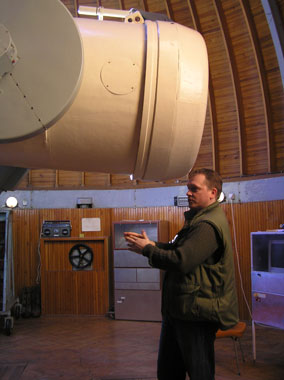
When bright bolid exploded over Central Europe on February 28, 2010 nobody
assumed, that remnants of this sky wanderer could be found. But it indeed
was! This was a result of succesful cooperation of amateurs and professional
astronomers from three countries - Hungary, Slovakia and Czech Republic.
Everyone who followed the story of meteorite Košice, could have noticed
also your involvement. You "played" your part in the beginning of this story.
How did this exactly happen?
I had only a marginal role. I forwarded the video with captured bolide from TV news,
contacted its owner and forwarded this information to other astronomers. That was all.
Further communication with the owner and processing of video file (this was done by
colleagues from Czech Republic), supply of the instruments for measurements, necessary
in-place analysis, almost everything was carried out by Antal Igaz. We helped him of
course, but he was the main player. He sent the data needed for computations of object
trajectory in space derived from the video to other professionals.
You also commented on this event in the Hungarian TV news. Did you think that it will
end with such a success?
No, I thought that this meteoroid was completely burned in the atmosphere.
But luckily it did not happen that way. After computations of the impact location,
we visited that place, but did not find anything.
You are geography teacher by profession, but you work as astronomer since
you got your diploma. How did you discover astronomy?
It was straight forward. I was interested in natural sciences since my childhood.
I read all available books on this subject and I enjoy watching programs on TV.
If I weren´t working as an astronomer, I would have been as a volcanologist or
meteorologist. I remember that I received my first astronomy book at age of 12
as a Christmas present. My parents noticed that two pages in the atlas of the
world, about Moon and the planets, were worn off completely from browsing over
and over, so they bought me a complete book.
I cannot recall a specific event, which led me to astronomy. It just happened.
But it must have been a helpful accident that my childhood friend Ákos Kereszturi
lived next door and we started to attend astronomy club together. Later he became
an excellent planetary scientist and specialist for Mars. I remember how we decided
to watch Austin comet back in 1990 (to find a dark spot for observation in Budapest
was almost impossible). We climbed the Rózsadomb hill and near the hotel SZOT we
found a dark place, but the watch-man came to us and wanted to know what we were
doing there. We told him about chasing a comet. He left us alone, but who knows
whether he believed us ...
You hunt for exoplanets, supernovas, but your favourite astronomical
targets are asteroids. How did you "discover" minor planets?
As I said I was interested in comets first, but if someone takes interest in this
fuzzy objects, sooner or later ends up with asteroids. At least this happened to
me. After my first observation of a comet, I wanted to observe asteroids too. And
I was also captivated by possibilities of discovery. I think that almost every
amateur astronomer dreams about discovering comets. And when we talk about
discoveries, there is also chance to discover asteroids, novas or supernovas.
Nowadays, all of these objects can be discovered by amateur astronomers. When
I carried out my first astrometric measurement of an asteroid on October 19,
1996 in Szeged, I already had in my repertoire more than 100 comets observed
visually and the same number of asteroids.
Do you remember how you discovered your first minor planet?
Of course, I do very well. I started my hunt for asteroids with my friend László
Kiss in Szeged. He was at that time postgraduate at University of Szeged. When we
visited Konkoly Observatory at Piszkéstető during astronomical summer camp next
summer, it occurred to him, that in the fall we should come back to do some
observations! As the observatory was open to cooperative work, we got observation
time for their Schmidt telescope, the one I use for asteroid hunt ever since.
I discovered most of my minor planets with it.
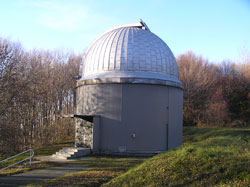
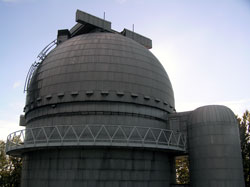
Our first working week was in November 1997. We waited 6 days and 7 nights in a
thick fog which did not allowed us to observe a single minute. Next January it
was little bit better, we had one clear night. On acquired images I found a lot
of new objects! At that time I realised how powerful instrument this telescope
was. In February we returned to Piszkéstető with a clear goal to observe the
selected part of sky in two consecutive nights.
You need observations from two nights in order for the Minor Planet Centre (MPC)
to assign your discovery a provisional designation. The weather was helpful this
time, so we accomplished our aim. But it was not possible to process and measure
images right after observations. I did it when I returned home to Szeged. I sent
all positions to MPC and hoped that there would be some objects caught by us on
both nights. Soon afterwards I received designation 1998 DA33 for my first asteroid.
You can find it now as (91024) Széchenyi. In those days there were just a few
asteroid hunters. Near Earth Asteroid Tracking (NEAT) was running as the only big survey.
Other survey program, LINEAR just started, so posting your observations
few days or even a whole week after the discovery, did not threaten losing the right
as a discoverer. My thrill from being a discoverer was repeated again in April
1998 when I found another 2 asteroids. So my counting has started.
You have more than 500 discovery credits, which one is your favourite one?
I think that (84 921) Morkoláb is my favourite. I caught this minor planet during
the total lunar eclipse on November 9, 2003. I prepared my observing schedule well
in advance and I knew that I could turn those 90 minutes of totality to my advantage
and observe several earlier discovered objects and perhaps even discover new ones.
Although there are more than four hundred thousand asteroids, I did not hear
about any discovered during lunar eclipse.
What is the driving force behind continuing your quest?
When I found my first asteroid, it crossed my mind that how long I would be able
to enjoy my new discoveries for? And I cannot answer this question to this day.
When I am waiting for the designation mail from MPC, I am excited just like in
1998. My joy from a new discovery after 13 years is the same, it makes me still
fascinated. Of course, you need some kind of goal all the time. It is the total
number of discoveries for me, at the beginning it was 10, then 100, 500 and
presently it is 1000 asteroids. Last year I had a slow down because to reach 1000
discoveries seemed too far away. But Konkoly Observatory lately purchased a powerful
CCD camera thanks to the government funding program "Expansion", which increased
the number of new discoveries 10 times. This new setup (the 0.60 m Schmidt
telescope and the new CCD camera) enables to make discoveries of not only 2-3,
but even 20-30 unknown objects...
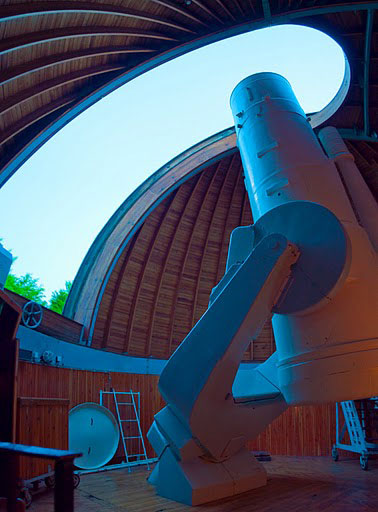
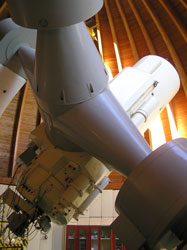
Besides your own images you also regularly scan archived CCD images taken by NEAT/
Palomar. Where did you learn about this SkyMorph data archive?
I came across SkyMorph by browsing on internet, but at first I did not think of
it as something useful and I did not use it. Then Brigita Sipőcz, one of my
students took part in summer astronomy camp in Visnjan, Croatia, where she worked
in minor planet group and learned how to use SkyMorph together with Astrometrica
software. Since then we measured many thousands of positions from this archive
for several hundreds of asteroids and also found about 60 new objects.
You started to search this archive in time, before MPC changed the credit rule
for NEAT discoveries. The big "SkyMorph hunters" of those times gave up their
hunt for unknown objects right after its modification. Did this change affect your next searches?
I was interested in precovery positions of my discoveries from Piszkéstető
from start, in hope that they would receive permanent number as soon as possible.
I have never been interested in search for unknown objects, but when I came across
such an unidentified asteroid, I measured its position too. I just could not left
it there unnoticed. All objects were worthy of another search. So when
I found more positions for it, I sent it to MPC. The total number of minor planets
was increased by another new object, although I was not credited with its discovery.
It was satisfying enough for me, that I was able to help.
Your "home" observatory was already mentioned, Konkoly observatory in Matra hills,
on Piszkéstető. There, far from city lights, you have been observing with a 0.60m
Schmidt and a 1m Ritchey-Chrétien-Coudé. During your career you worked also from
several other locations, both in Hungary and abroad. You were a visiting astronomer
at Siding Springs in Australia. How did you get there and what was your research program?
I won the internship from Eötvös grant supported by Hungarian government and
University of Szeged. I was guest at my friend László Kiss' place, who we mentioned
earlier. I stayed on this wonderful continent for 3.5 months. My object of study
was comet Elst-Pizarro, which was approaching its perihelion. We observed it for
3 nights, unfortunately its activity was so weak, that even the 2.3m telescope
was not able to show its dust cloud. But I successfully observed several main
belt comets and my biggest "catch" was observation of Hale-Bopp comet at an
amazing distance of 25.8 AU, 10 years after its perihelion passage.
Siding Springs Observatory is renown for its comet discoveries. Did you meet there
any famous comet hunter?
Yes, I did. I met five discoverers. One of them was the well known Rob McNaught,
and I interviewed him for our Hungarian Meteor magazine. Next were Gordon Garradd,
Malcom Hartley, Steven Lee and Quentin Parker. McNaught has 57 comet discoveries
and comet Hartley nowadays attracts attention of many astronomers worldwide. Last
two astronomers are credited each with 1 comet discovery.
What is your greatest experience from your stay Down Under?
I was most impressed by the fact, that people can live in such a different way
as us here in Central Europe. Adherence of rules is what makes our life easier,
moreover people in Australia are relaxed and friendly, which makes life happier.
At least in area of Sydney it does.
Every month you spend a week on Piszkéstető and for other 3 weeks you work in
the office in Budapest as an executive secretary of Hungarian Astronomical
Association (HAA). What is your main duty in this position?
It is not one duty, but many smaller ones. We prepare publications in printed and
electronic versions for our monthly magazine Meteor and also for our web site.
We organize observational meetings, lectures, summer camps. I am also leader of
astronomical club, I often answer questions about telescopes and about astronomy
in general. I maintain accurate data of HAA members, post our publications and
I even do cleaning of our offices.
HAA was founded in 1989 in order to popularize astronomy to general public.
Its activities are very important. How do you evaluate amateur astronomy in Hungary?
I think it is a worldwide rarity, that one organization, which associates amateur
astronomers from the whole country (more than 1600 members renew their memberships
every year) can do so much work on popularizing astronomy. So I take it for good,
especially when we take in account that it is all done just by a few people.
Unfortunately the situation in general is not very favourable, people often prefer
their own interests and those regarding community are only adjacent.
Do you consider yourself to be an observer or popularizer of astronomy?
I am an observer astronomer, who can interpret astronomical news in simple and
understandable manner to the general audience.
Besides your articles about latest news in astronomy published in your monthly
journal, you write also for Meteor Astronomical Almanac and web site of HAA.
You are also author of two books on asteroids. I assume that you read a lot, too.
What is your favourite book?
It is Out of the darkness, story of discovering Pluto. I reckon it is not necessary
to explain why. This book was written by Pluto's discoverer Clyde Tombaugh and
the renown astronomer Patrick Moore.
Do you have a favourite astronomy related quote?
Yes I have. In fact it is more of a principle than a quote, and it should be in
minds of every researcher. It is the so called Occam´s razor: when there are more
explanations for a certain phenomenon, you should choose the least complicated one.
Finally I wonder whether you can name someone from great astronomers, who inspired you?
I can name already mentioned Tombaugh, or Edward Barnard and some others too.
Even though they started with astronomy as a hobby, they achieved something
extraordinary and at the end they became respected even by professionals.
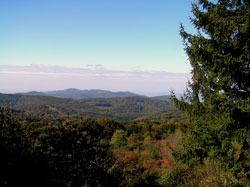
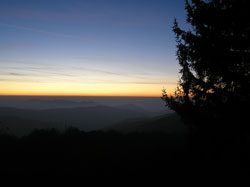
Instead of an epilogue
Ten years ago I mentioned in our interview that you work both day and night. Is it the same nowadays? What does your normal working day look like?
There is no shortage of work even now, only its character has changed a bit in recent years. We succeeded in one competition from the Hungarian government worth about EUR 3 million, which enabled us to significantly modernize our devices, as well as employ a larger number of technicians and researchers. At the same time, this meant quite a lot of administrative work, not to mention public procurement with often seemingly irrational rules. However, we now have a nationwide network of meteor cameras, we have acquired an 80-cm telescope, an ionospheric radar and several CCD cameras.
Almost five years have passed since you won in that competition. And the first results came just now. Can you introduce them to us?
Currently you are the discoverer of 421 asteroids. In addition, more than a thousand asteroids are waiting for a numbering and you are preliminarily listed as their discoverer. This, of course, can change and eventually someone else will gain discovery credit. Was there, among your discoveries, asteroid that surprised you?
Surprises were earlier, in the beginning of my career, at that time one could find an unknown main belt asteroid even in a small elongation and in the evening sky, or even relatively bright one (17th - 18th magnitude) turned out to be unnoticed. Of course, after the arrival of surveys with large telescopes and with a large field of view, and the introduction of new rules for acknowledging discoveries in 2010, this period is over. Now I'm more surprised to find any asteroid with the 60-cm Schmidt telescope at all. So, NEO and objects with higher eccentricity remain. One era is over, for our smaller devices for sure.
Confirmation of new NEOs and comets is one of your current observation programs. In addition, you search for periodic comets, especially for those that were observed only at the discovery. The periodic comet receives a permanent number after observing on the next return. You are successful in this area, will you reveal your secret, how you do it? Is there a competition as well?
There is a kind of friendly competition between amateurs and professional comet astronomers, but this topic is not so hot and everyone will find success in it. Sometimes the sky is clear here, other times in a different place, so everyone miss a few returning comets. I have no big secret, my advantage is perhaps a relatively larger telescope, especially the large field of view offered by the Schmidt system, because these comets like to move quite far from their predicted positions.
You visited the University of Texas Observatory in Austin, USA, McDonald Observatory, in 2018. What was the purpose of this visit?
As I mentioned, the period of asteroid discoveries is over and my attention has turned to another area. József Vinkó, my colleague and respected supernova expert, invited me to go on this study trip with him. American colleagues there are investigating the subsequent H-alpha radiation of old, decades-old, even centuries-old supernovae using the observatory's 2.7-meter telescope. This device was made in the old style, so the telescope and the dome have huge dimensions. It was amazing to observe with it, or just walk around the dome building under a beautiful night sky. The local country is also beautiful, and last but not least, there and then was formulated in me a great dream of the next decade. We need such a telescope in Hungary! Currently, the largest telescope in our country has optics with a diameter of 1 meter, but in the second decade of the 21st century, I would like to build a 2.5-meter or, if you want, a 100-inch telescope in Hungary.
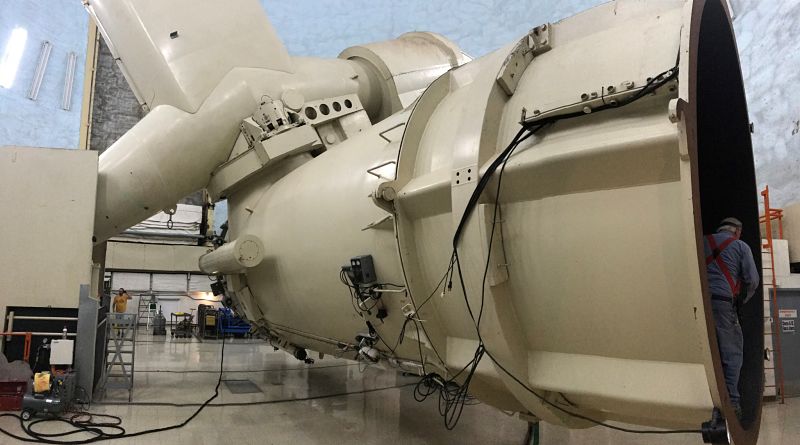
György Kulin discovered the asteroid 1940 AB in 1940, which was named in 2017 as (10258) Sárneczky. 77 years have passed since its first observation. Why did it take so long and how did it happen?
The main reason was that this object was also recorded as a 1940a comet. This classification of the comet was rejected by Brian Marsden of the MPC decades ago, because the orbital solution for main belt asteroid also met the observations. I think sometime in the 80's we were visited by Michael A'Hearn, who died a few years ago, and he personally checked photo plates with my colleague Imrich Tóth, but they found no signs of comet activity. A review of the original reports also revealed that Kulin itself first identified it as an asteroid, only later, after an initial calculation of the orbital elements, changed it into a comet. It is possible that Kulin came to this conclusion on the basis of lower quality of photographic plates, he may have only longed to discover a comet, we will never know the whole truth. It is certain that in 1998 the object was linked with observations of several asteroids and soon received a permanent number.
It has not shown cometary activity since then and all other parameters of the orbit suggest that it is a common main belt asteroid, MPC finally allowed its naming in 2017 after several unsuccessful attempts. From here you know the story ...
Yes, and it was a pleasure to take the whole story forward. During my visit to Piszkéstető in March 2017, we also talked about asteroids names, and so it came out that asteroid "Sárneczky" does not exist yet. You said, you would be honored if Kulin's discovery was named after you. Subsequently, I contacted Gareth Williams at the MPC, who was in charge of naming and told him the story of the asteroid 1940 AB. After that it went fast. I received a link to a website where I could submit the naming proposal and after half a year the name was approved.
Sometimes you have to take a break from work and I don't think about sleeping now. What is your best way to relax?
The best relax for me is by sports, whether active or watching it. At the moment, it's mostly cycling, and I watch almost all kinds of sports on TV, only basketball, despite its great popularity, I've never liked.
